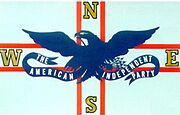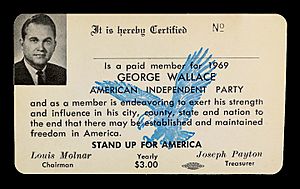American Independent Party facts for kids
Quick facts for kids
American Independent Party
|
|
|---|---|
 |
|
| Chairman | Victor Marani (CA) |
| Vice Chairman | James Mallamace |
| Founders | Bill Shearer Eileen Knowland Shearer |
| Founded | July 8, 1967 |
| Split from | Democratic Party Republican Party |
| Headquarters | PO Box 1479. Freedom, California 95019 |
| Ideology | American nationalism Anti-communism Paleoconservatism Right-wing populism Formerly, now factions: Populism Economic populism Syncretic politics Formerly: Racial segregation |
| Political position | Far-right |
| National affiliation | American Independent Party |
| Slogan | "No North, No South, No East, No West – One Great Nation, Heaven Blessed!" |
| State Senate |
0 / 40
|
| State House |
0 / 80
|
| Party flag | |
 |
|
The American Independent Party (AIP) is a political party in the United States. It was started in 1967. The party is most famous for choosing George Wallace as its candidate for president in 1968. Wallace was a former Governor of Alabama. He won votes in five states during the 1968 United States presidential election. He ran against Richard Nixon and Hubert Humphrey.
Wallace's campaign focused on ideas that were popular with everyday people. He was strongly against communism and supported "law and order." This meant he wanted strict rules to keep society safe. He appealed to white voters who worked in factories and other jobs. Wallace was also known for supporting racial segregation, which meant keeping different races separate. In 1976, the party split into two groups: the modern American Independent Party and the American Party. From 1992 to 2008, the AIP was connected to the national Constitution Party in California.
Contents
The Party's Beginning
In 1967, Bill Shearer and his wife, Eileen Knowland Shearer, started the AIP. They chose George C. Wallace as their presidential candidate. For vice president, they picked Curtis E. LeMay, a retired U.S. Air Force General. Wallace was on the ballot in every state. However, he was not always listed as representing the American Independent Party. For example, in Connecticut, he was on the ballot for the "George Wallace Party."
The Wallace and LeMay team received 13.5 percent of the total votes from people. They also won 46 electoral votes. These votes came from the states of Arkansas, Louisiana, Mississippi, Georgia, and Alabama. Since the 1968 election, no other third-party candidate has won more than one electoral vote. A third-party candidate is someone running for president who is not from the two main parties (Democratic or Republican).
In 1969, people from forty states created the American Party. This party was meant to follow the American Independent Party. In some places, like Connecticut, it was called the American Conservative Party. The party's flag was adopted in 1970. It shows an eagle holding arrows over a compass. A banner below the eagle reads "The American Independent Party."
In 1972, the American Party chose John G. Schmitz from California as their presidential candidate. They picked Thomas Jefferson Anderson from Tennessee as his running mate. Both were members of the John Birch Society. This team won over 1.1 million votes. This was the most votes the party received after Wallace's run.
After the Party Split
In 1976, the American Independent Party divided. One part became the more moderate American Party. This group included conservatives from the northern states and supporters of John Schmitz. The other part remained the American Independent Party. This group focused more on the southern states. Both parties have chosen candidates for president and other positions. However, neither party has had much success across the country. The American Party has not been on the ballot in any state since 1996.
In the early 1980s, Bill Shearer led the American Independent Party to join the Populist Party. From 1992 to 2008, the American Independent Party was connected to the national Constitution Party in California.
Leadership Changes
A disagreement happened within the American Independent Party during the 2008 presidential campaign. Two groups claimed to be in charge. One group recognized Jim King as the chairman. The other group recognized Ed Noonan as the chairman. Noonan's group kept control of the party's main website. King's group used the party's blog.
King's group decided to stay with the Constitution Party. They supported its presidential candidate, Chuck Baldwin. However, Baldwin's name was not printed on California's ballots. King's group tried to get him on the ballot, but their case was dismissed.
Noonan's group voted to leave the Constitution Party. They joined a new party called America's Party. This party was started by Alan Keyes for his own presidential campaign. Since Noonan was listed as the party chairman in California, Keyes was added to the state ballots as the AIP candidate.
Presidential Candidates
| Year | Presidential nominee |
Home state | Previous positions | Vice presidential nominee |
Home state | Previous positions | Votes | Notes |
|---|---|---|---|---|---|---|---|---|
| 1968 |  George Wallace |
Governor of Alabama (1963–1967) |
 Curtis LeMay |
Chief of Staff of the Air Force (1961–1965) | 9,906,473 (13.5%) 46 EV |
Wallace and LeMay won five states. They received 45 electoral votes. They also got one extra vote from a North Carolina elector. This is the last time a third-party team won all electoral votes from at least one state. | ||
| 1972 |  John G. Schmitz |
Member of the U.S. House of Representatives |  Thomas J. Anderson |
Magazine publisher | 1,099,482 (1.4%) 0 EV |
|||
| 1976 |  Lester Maddox |
Governor of Georgia (1967–1971) |  William Dyke |
Mayor of Madison (1969–1973) | 170,531 (0.2%) 0 EV |
|||
| 1980 |  John Rarick |
Member of the U.S. House of Representatives | Eileen Shearer | Co-founder of the American Independent Party | 41,268 (<0.1%) 0 EV |
|||
| 1984 |  Bob Richards |
Retired Olympic athlete |  Maureen K. Salaman |
Writer, nutritionist | 66,336 (0.1%) 0 EV |
|||
| 1988 | James C. Griffin | Candidate for U.S. Senator from California | Charles Morsa | 27,818 (<0.1%) 0 EV |
||||
| 1992 |  Howard Phillips |
Chairman of The Conservative Caucus | Albion W. Knight | Presiding Bishop of the United Episcopal Church of North America | 43,369 (<0.1%) 0 EV |
|||
| 1996 |  Howard Phillips |
Chairman of The Conservative Caucus | Herbert Titus | Lawyer, writer | 184,656 (0.2%) 0 EV |
|||
| 2000 |  Howard Phillips |
Chairman of The Conservative Caucus | Curtis Frazier | Candidate for United States Senator from Missouri | 98,020 (0.1%) 0 EV |
|||
| 2004 | Michael Peroutka | Lawyer |  Chuck Baldwin |
Pastor, radio host | 143,630 (0.1%) 0 EV |
|||
| 2008 |  Alan Keyes |
Assistant Secretary of State for International Organization Affairs | Wiley Drake | Minister, radio host | 47,694 (<0.1%) 0 EV |
|||
| 2012 | Tom Hoefling |
Activist | Robert Ornelas | Activist | 40,641 (<0.1%) 0 EV |
|||
| 2016 |  Donald Trump |
Businessman |  Mike Pence |
Governor of Indiana (2013–2017) | 62,984,825 (46.1%) 304 EV |
Donald Trump did not ask for the AIP nomination. California law allows one party to nominate a candidate from another party. This means the choice can be shown on the ballot. | ||
| 2020 |  Rocky De La Fuente |
Businessman |  Kanye West |
Rapper, producer and fashion designer | 60,160 (0.34%) 0 EV |
|||
| 2024 |  Robert F. Kennedy Jr. |
Environmental lawyer | Nicole Shanahan |
Attorney | 681,450 (0.46%) 0 EV |
Robert F. Kennedy Jr. stopped his campaign and supported Donald Trump. |
The Noonan group kept control of the American Independent Party in California. The party did not nominate Chuck Baldwin in 2008 or Virgil Goode in 2012. Because of this, neither candidate could get on the California presidential ballot as an independent.
California Governor Candidates
| Year | Candidate | # Votes | % Votes |
|---|---|---|---|
| 1970 | Bill Shearer | 65,847 | 1.01 |
| 1974 | Edmon V. Kaiser | 83,869 | 1.34 |
| 1978 | Theresa F. Dietrich | 67,103 | 0.97 |
| 1982 | James C. Griffin | 56,249 | 0.71 |
| 1986 | Gary V. Miller | 50,547 | 0.68 |
| 1990 | Jerome McCready | 139,661 | 1.81 |
| 1994 | Jerome McCready | 133,888 | 1.55 |
| 1998 | Nathan Johnson | 37,964 | 0.45 |
| 2002 | Reinhold Gulke | 128,035 | 1.71 |
| 2003 | Charles Pineda, Jr. | 1,104 | 0.01 |
| 2003 | Diane Beall Templin | 1,067 | 0.01 |
| 2006 | Edward C. Noonan | 61,901 | 0.71 |
| 2010 | Chelene Nightingale | 166,312 | 1.65 |
| 2014 | No Candidate | N/A | N/A |
| 2018 | No Candidate | N/A | N/A |
| 2021 | No Candidate | N/A | N/A |
Party Leaders
- Bill Shearer: 1967–1999
- Nathan Johnson: 1999–2002
- Jim King: 2002–2004
- Nancy Spirkoff: 2004–2006
- Edward C. Noonan/Mark Seidenberg: 2006–2008
- Disputed: Jim King and Markham Robinson claimed chairmanship: 2008–2024
- Victor Marani/James Mallamace: 2024–current
Voter Registration in California
In 2016, about 3% of California's 17.2 million voters were registered with the American Independent Party (AIP). This made it the third-largest political party in the state by registration. The Democratic Party had 43% of voters, and the Republican Party had 28%. About 24% of voters chose "no party preference."
However, many people think that the party keeps its status because voters mistakenly register with the AIP. They might think they are signing up as "independent" voters. In California, being an "independent" voter is officially called "no party preference."
A 2016 investigation by the Los Angeles Times suggested that many AIP voters might have registered by mistake. They thought they were registering as independent voters. A survey of AIP voters showed that most did not mean to register with the party. The investigation pointed out that the party's name can be confusing.
The 2016 survey found that 73% of registered AIP voters said they had "no affiliation." Another 3% said they were "undecided." After learning what the AIP stands for, 50% of these voters wanted to leave the party. The Times looked at voting records. They found that many famous people, like Sugar Ray Leonard, Demi Moore, Emma Stone, and Kaley Cuoco, made this mistake. In 2008, Jennifer Siebel also tried to change her party. She checked the American Independent box. She thought that was what independent voters were supposed to do.
This confusion means that people who accidentally register with the AIP cannot vote in presidential primary elections. In the past, they could not vote in any party primary elections except the AIP's. Many California election officials have worried about the confusion caused by the party's name. Kim Alexander, who leads the California Voter Foundation, said the California voter form was "confusing and somewhat misleading."
However, since 2012, California has a "top-two" primary system. This means all voters can take part in non-presidential primary elections. These are elections where candidates are chosen for public office. Presidential nominations and elections for party committees are still only for voters registered in that party. But a party can choose to let voters with "No Party Preference" vote in their presidential primary. Also, voters can now re-register to a different party on election day. This helps to fix the problem.
See also
 In Spanish: Partido Independiente Americano para niños
In Spanish: Partido Independiente Americano para niños


